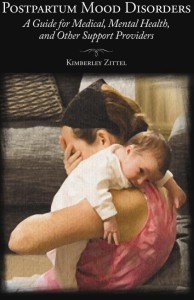NASW Press: New Book Offers Guide for Dealing with Postpartum Blues
 Kimberley Zittel had a master’s degree in social work and was practicing as a clinical social worker for six years when she had her first son. She specialized in mental health and medicine.
Kimberley Zittel had a master’s degree in social work and was practicing as a clinical social worker for six years when she had her first son. She specialized in mental health and medicine.
Still, Zittel became a victim of postpartum depression, a condition that has afflicted 430,000 to 645,000 women in the United States.
“When we returned home, I had the baby blues. I remember crying to my mother, ‘Things will just never be the same again,” said Zittel, who is a National Association of Social Workers member.
In all of her years of professional training leading up to a doctorate Zittel had never heard postpartum depression mentioned. That is why she decided to write Postpartum Mood Disorders: A Guide for Medical, Mental Health and other Support Providers. The book is a new offering from NASW Press.
The book is a tool to help prepare families, social workers, other counseling professionals and medical professions to help women struggling with postpartum mood disorders. It explores the theories, epidemiology, risk factors, at-risk populations and treatment options for the disorder.
By the time readers finish the book, Zittel hopes they will understand the disorder better and the need for more community programs to help women as well as their partners, children, family members and support systems.
The National Association of Social Workers offers members an array of cutting-edge publications. For information on NASW books and journals visit the NASW Press Web page by clicking here.
| Leave A CommentAdvertisement
2 Comments
Leave a Comment
You must be logged in to post a comment.



This book is actually a guide that goes well beyond the “postpartum blues.” In fact, it helps to debunk the myth that “postpartum blues” is the same as postpartum depression and it also thoroughly explains the various other perinatal mood …disorders that women may experience not only during the postpartum period but also during pregnancy. It is a must read for any professional who works with the perinatal population. This issue is much more prevalent than most people are aware of and recognition, awareness, proper assessment and appropriate treatment options are the only way women will get the help they deserve. Social workers owe it to their clients to educate themselves on this topic!!
Thank you, Jodi, for pointing this out. The “Blues” is experienced by up to 80% of women for a maximum of 14 days. This experience is NOT considered a mood disorder. It is when sadness and depression last longer than two weeks and increases in intensity over time and negatively affects functioning that it becomes a problem that CAN BE treated. Postpartum depression is the number one complication of childbirth. In addition, there are six commonly recognized postpartum mood disorders – the “Blues” is not one of them. They include depression, generalized anxiety, panic, obsessive compulsive disorder, posttraumatic stress, and psychosis. Typically, postpartum psychosis only affects 1-2 in 1,000 – and of these 4%-5% will kill herself and/or her baby. These are often the cases we here about in the media. While important, this publicity often makes it more difficult for families to talk about mood changes during or after pregnancy – fearing they will be categorized as those show cased in the media. I hope this book will help others seek help, help others, and improve the overall family lives of our citizens.